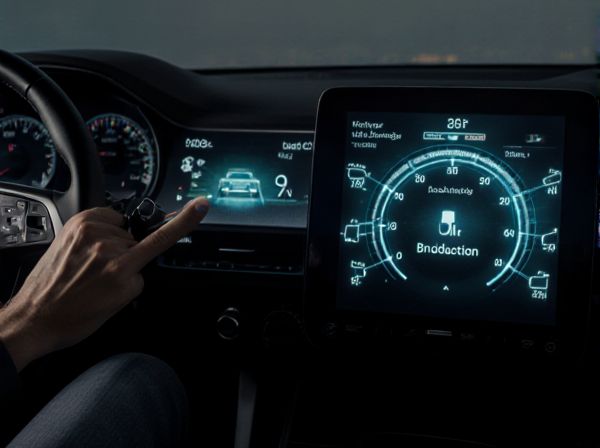
Photo illustration: Gesture Control vs Haptic Control
Gesture control allows you to interact with devices using hand or body movements, offering an intuitive and contactless experience ideal for smart environments and wearable technology. Haptic control provides tactile feedback through vibrations or forces, enhancing user engagement by simulating touch sensations in virtual reality, gaming, and mobile devices. Choosing between gesture and haptic control depends on whether you prioritize hands-free navigation or immersive touch feedback in your applications.
Table of Comparison
| Feature | Gesture Control | Haptic Control |
|---|---|---|
| Definition | System using hand movements to operate vehicle functions without touch. | Touch-based feedback system providing tactile responses for controls. |
| Interaction Type | Contactless, motion-based input | Touch input with vibration or force feedback |
| Response Feedback | Visual or audio cues | Tactile feedback enhancing user confirmation |
| Accuracy | Medium; depends on sensor quality and lighting | High; precise control through direct touch |
| Usability in Motion | Good but can be affected by hand positioning | Excellent; reliable in all driving conditions |
| Learning Curve | Moderate; requires user adaptation to gestures | Low; intuitive and similar to touchscreen use |
| Common Applications | Media control, navigation, call handling | Volume adjustment, menu navigation, climate control |
| Advantages | Hands-free operation; reduces physical contact | Immediate feedback; enhances safety and accuracy |
| Disadvantages | Potential misinterpretation of gestures | Requires physical touch; may distract if overused |
Introduction to Gesture Control and Haptic Control
Gesture control enables users to interact with devices using physical movements, relying on sensors and cameras to detect hand or body gestures for intuitive command input. Haptic control provides tactile feedback through vibrations or force, enhancing user experience by simulating touch sensations in virtual or remote environments. Both technologies are integral in advancing human-computer interaction by offering natural and immersive control methods.
How Gesture Control Works: Key Technologies
Gesture control operates through sensors like cameras and infrared detectors that capture hand and body movements, translating them into digital commands using computer vision algorithms. Key technologies include depth-sensing cameras, machine learning models for gesture recognition, and signal processing techniques that interpret spatial data in real time. This combination enables intuitive interaction with devices by accurately detecting and responding to user gestures without physical contact.
Understanding Haptic Control: Fundamental Concepts
Haptic control refers to technology that enables users to interact with devices through the sense of touch by providing tactile feedback, such as vibrations or force sensations. It relies on sensors and actuators to simulate realistic touch experiences, improving user engagement and precision in applications like virtual reality, robotics, and medical simulations. Understanding haptic control involves grasping its core components: sensor input detection, processing algorithms, and actuator response mechanisms that deliver precise stimuli to the user.
User Experience: Gesture vs Haptic Interactions
Gesture control offers users an intuitive, touch-free interaction method that enhances convenience and accessibility, especially in smart devices and AR/VR environments. Haptic control provides tactile feedback, allowing users to feel textures, vibrations, and forces, which improves precision and engagement in gaming, virtual reality, and mobile devices. The choice between gesture and haptic interactions depends on the desired sensory experience, with gesture control prioritizing spatial motion recognition and haptic control emphasizing physical sensation and responsiveness.
Applications across Industries: Gesture & Haptic Controls
Gesture control technology enables intuitive interaction across industries such as healthcare, automotive, and consumer electronics by detecting body movements to operate devices hands-free. Haptic control enhances user experience in virtual reality, gaming, and remote robotics by providing tactile feedback that simulates physical sensations. Both technologies improve accessibility, efficiency, and user engagement by integrating natural human inputs with advanced digital systems.
Accuracy and Reliability: A Comparative Analysis
Gesture control offers intuitive interaction driven by motion detection but may suffer from reduced accuracy due to environmental lighting and sensor limitations. Haptic control provides precise tactile feedback, enhancing reliability and user confidence through physical sensations that confirm input recognition. Comparative studies indicate haptic systems generally outperform gesture controls in consistency and accuracy, making them preferable for tasks requiring high precision.
Accessibility and Inclusivity Considerations
Gesture control enhances accessibility by enabling users with limited hand dexterity to interact with devices through simple movements, reducing reliance on fine motor skills. Haptic control provides tactile feedback, crucial for individuals with visual impairments, improving device usability through touch-based confirmation signals. Both technologies promote inclusivity by catering to diverse user needs, but combining gesture and haptic controls can create more adaptive and accessible user interfaces.
Integration with Emerging Technologies (AR, VR, IoT)
Gesture control integrates seamlessly with AR and VR systems by enabling intuitive, hands-free interaction, enhancing user immersion through natural motion detection using cameras and sensors. Haptic control complements these technologies by providing tactile feedback, improving user experience in virtual environments and IoT devices through precise force, vibration, and texture sensations. Combining gesture and haptic control drives innovation in smart wearables, automotive interfaces, and remote robotic operations, maximizing the functionality of AR, VR, and IoT ecosystems.
Challenges and Limitations of Both Control Methods
Gesture control faces challenges in accurately interpreting complex or subtle movements due to variability in user behavior and environmental conditions, leading to potential misrecognition and limited precision. Haptic control struggles with the high cost and complexity of developing realistic tactile feedback systems, often resulting in limited range and fidelity of sensations. Both methods encounter limitations in user fatigue and accessibility, affecting sustained interaction and broad usability across diverse populations.
Future Trends: Gesture and Haptic Control Innovations
Future trends in gesture control emphasize AI-driven recognition systems that improve accuracy and contextual understanding, enabling seamless interaction in smart environments. Haptic control innovations focus on advanced tactile feedback technologies, such as electrostatic and ultrasonic haptics, to create immersive virtual experiences and enhance remote robotic operations. Integration of gesture and haptic controls is anticipated to revolutionize human-machine interfaces by combining intuitive motion sensing with realistic touch sensations for diverse applications.
 caratoz.com
caratoz.com